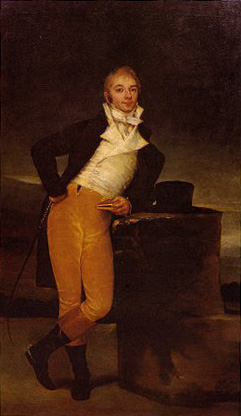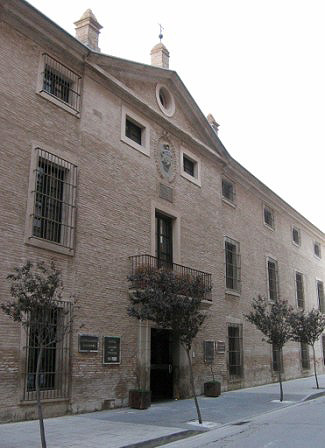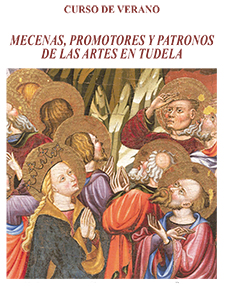PATRONS, PROMOTERS AND PATRONS OF THE ARTS IN TUDELA
28 August 2014
The Enlightenment's leading figures
D. Pablo Guijarro Salvador. Ph.D. in Art History
The Sociedades Económicas de Amigos del País are representative institutions of the Spanish Enlightenment movement, promoted by the committee of Castile to achieve the participation of the privileged classes in the government's reformist policy. In their meetings, they wrote memoirs and reports on the means to achieve the progress of the country, through the introduction of new agricultural and irrigation techniques, the increase of industry or the opening of schools of first letters and professional schools. The profile of their members are nobles, military men, civil servants or merchants linked to the Bourbon administration, in which they had developed their degree program thanks to a careful training and their family networks.
If we identify as enlightened those who decide to participate in the institutions of enlightened sociability, in Tudela we find a good issue of them, the members of the Sociedad Tudelana de los Deseosos del Bien Público, the only Society of Friends of the Country that was founded in Navarre. quotation It arose in 1778 from an erudite gathering around the figure of Francisco Magallón, V Marquis of San Adrián, and it was attended by dozens of Tudelanos belonging to the most distinguished lineages of the city. The Marquises of San Adrián, Francisco Magallón and his son José María Magallón y Mencos, cultured characters open to new ideas, were able to spread their modern spirit to the elites of a small town, whose economic, social and cultural characteristics did not invite the existence of a dynamic enlightened center. The portrait of José María Magallón y Mencos, VII Marquis of San Adrián, painted by the brilliant Francisco de Goya in 1804 -one of the jewels of the Museum of Navarre-, constitutes an irrefutable test of the modernity of this family. Thanks to an important economic investment in his Education, which led him to spend some time in Paris, and to his kinship networks, he would marry one of the richest heiresses of that time, the Marquise of Santiago. As is well known, the Marquis of San Adrian was one of the Frenchmen who collaborated with the Napoleonic regime, which condemned him to exile.

Portrait of José María Magallón y Armendáriz, VII maquis of San Adrián, by Francisco de Goya (1804)
Museum of Navarre
In its search for the public good, the Economic Society maintained an important intellectual work in the fields of agriculture, industry, commerce, history and poetry. Unfortunately, the works produced by its members remained on paper, with the exception of the Casa de Misericordia, which is the main bequest of the Enlightenment in the city. Even so, its initiatives, such as the publication of printed works, the training of a Library Services with more than 5,000 volumes or the project of a seminar of nobles in the style of Vergara, tried to transform those aspects of the reality of Tudela that did not work.
The Royal House of Mercy, opened in 1791, is a prototypical charitable institution of the Enlightenment period. At that time the streets were populated by a large issue of false poor, who took advantage of the alms of religious orders and individuals. The hospices were intended, on the one hand, to help the real poor, and on the other hand, to confine the idle to force them to work and be useful to the country. The one in Tudela was created with the goods donated by the couple formed by Ignacio de Mur and María Huarte, although it was the latter who gave the foundation its form final. She empowered the Economic Society to sell its assets and erect the Casa de Misericordia, and even wanted the work to begin before her death. Her gesture was echoed in the Court, where she was held up as an example of true charity, that which is given during her lifetime. Even King Charles III became interested in the founder. The building was designed by the local architect José Marzal y Gil, but when it was sent to Madrid for approval, it was modified by the famous Ventura Rodríguez, who visited Tudela to discuss the work. Paradoxically, the building, which was intended to house the poor, has now been converted into a luxury hotel.

Façade of the foundational building of the Real Casa de Misericordia,
today transformed into a hotel
PROGRAM
Tuesday, 26th August
Three exceptional altarpieces for three promoters
Ms. Mercedes Jover Hernando. Museum of Navarre
The great patrons of the Renaissance, a mirror of humanism
María Concepción García Gainza. Chair of Navarrese Heritage and Art
Wednesday, 27th August
Around the patron saints
D. Ricardo Fernández Gracia
Chair of Navarrese Heritage and Art
Patrons and patrons of Tudela silverware
D. Ignacio Miguéliz Valcarlos
UNED Pamplona
Patrons and Patronages in the Collegiate ( visit guidada)
Ms. María Josefa Tarifa Castilla. University of Zaragoza
Thursday, 28th August
Town planning and civil architecture
D. Carlos Carrasco Navarro. Doctor in History of Art
The great men of the Enlightenment
D. Pablo Guijarro Salvador. Chair of Navarrese Heritage and Art.
Monarchy, patrons and nuns in the Company of Mary ( visit guided)
D. Ricardo Fernández Gracia
Chair of Navarrese Heritage and Art

